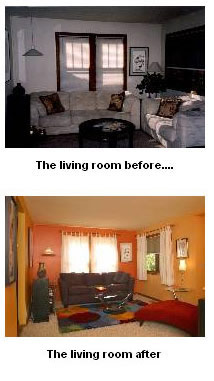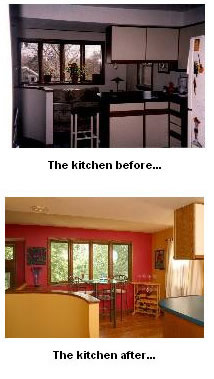Color: Transforming Pale into Powerful
By Jeanan Yasari, for The Wisconsin State Journal
"Color is meant for the perpetual enjoyment of the human heart."
John Ruskin - English Philosopher and Writer

Ever wonder what "Cherries Jubilee" or "Habanera Pepper" might provide at the end of a long day? "Serape" or "Saffron" could offer a similar escape, but probably to a more serene place.
These aren't exotic drinks or desserts, although they evoke the same promise. Rather they are a few of the shades that now grace the walls of my home. Admittedly, the painting project started with an element of fear, followed by, truthfully, shock, yet ultimately resulted in the home of my dreams. These new colors now draw me into each room with warmth, energy and calmness.
Diving In
Lately, the trend is toward using more color in home interiors. Experts say there is psychology behind color that impacts each of us in deep, personal and emotional ways. (See sidebar.)
Before starting the project, I thought a fresh coat of white paint would revive the dingy white walls of our house. Then a few friends encouraged me to incorporate color in my redesign plan. I was game for something new, but I wasn't confident in selecting the colors alone.
During the first of two at-home consultations with Jodie Amerell, a color consultant with InnerView Consulting, we discussed how to choose the right colors. She encouraged me to page through magazines and collect images that depicted how I would like to feel at home. At our second visit, we identified several colors that would give life to those feelings.
But after selecting an orange wall for the living room I felt only anxiety, which wasn't on my list. Jodie encouraged me to relax. "When I work with people on color, they get stretched beyond their comfort zone" she said. I was stretching alright- like an old, ill-fitting tube top. Jodie confidently assured me the end results would be worth this period of trepidation.
To ease the anxiety, Jodie hung large paint-sample sheets throughout the house to help me visualize the different hues throughout the day's changing light. I left the swatches up for a month before moving forward.
So What's So Tough About Painting?

The concept of selecting colors sounds simple, but when sharp sunrise "Golden Maize" abuts a fuscia-like "Powerful Pomegranate" you want a professional at your side. That means working with a painter who is willing to expand from the original plan and provide expert advice throughout the process. I chose to work with Rob Maveus, who owns Spruce Painting in Madison. "People often have a good idea of what they want at the start of a project, but remaining flexible during the process is key, particularly if you are trying bold changes in your home," said Maveus.
Each night I would come home to a new blaze of color, and sometimes audibly gasp as I walked through the door. With three different shades of gold and orange in the living room alone it took me days to acclimate. Soon the living room looked downright timid as I watched fuchsia transform the dining room. But it wasn't until a coat of bright lemon-yellow paint hurled itself across an adjoining dining room wall that I yelled, "Halt!" Luckily, whole walls had not been done. As was the case throughout the project, Maveus and his crew would first paint large test areas of each potential color in its designated area. This helped frame the future for me. The other colors were starting to work with me, but the lemon yellow was too much and it was time for a change of plans. In fact, this scenario repeated itself a few times during the course of the month-long project and we eventually adjusted many of our original color choices. "When you finally see your chosen color on the wall, you may realize you want something just a few shades lighter, darker, muted or brighter, or you recognize you actually like color so much that you want to change the plan altogether," noted Maveus .
That was the case in my upstairs office. The original plan called for a calm green and cream combination. But, I realized, there was no thrill in it. I must confess that I had come to need the vibrancy of the deep colors from the first floor. So, Maveus helped me pick out varying shades of red and yellow, and he installed new track lighting to increase the impact in the office. Now the resulting visual energy field makes working, even well into the evening, a delight.
Ta-Da!
Neighbors and friends quickly noticed a warm orange glow emanating from the front entry. As color drew them into our home, their responses ranged from "I want to sit in here. It's so warm!" to "How did you have the guts to do that?" A long-time friend and frequent visitor commented, "You bought all new art." In fact, we hadn't, but each piece took on an entirely new look against the vivid backdrop of complementary colors. Women are particularly drawn to the vibrant colors while some men, including my husband, Scott, are less enthusiastic about new hues. It seems, only a new, flat-screen TV could help "ease" the terrifying transition from cold to bold in our home. "Color stirs things up," said Maveus. "Women want to do it and men are often hesitant, but once the women finish the job, men often become the biggest supporters of color." The grind and often frenetic nature of day-to-day life causes some of us to discount the impact our home has on other aspects in our life. I am now a believer. The warmth and comfort of our revived space allows me to feel connected to my home. It is now a place from which I can draw energy to attain the focus I need in other aspects of my life. There's no question that color has proven its enormous potential to motivate, relax and even inspire me.
Sidebar: The Psychology of Color
Our personal and cultural associations affect our experience with color. We may react to colors as being warm or cool mainly because of long-held and often universal associations. Yellow, orange and red are associated with the heat of sun and fire; blue, green and violent with the coolness of leaves, sea and the sky.
"Color is more than psychological," said Professor Joy Dohr of the UW School of Human Ecology. "Color is light. Human beings have always related to natural light for a sense of well-being. Color offers the awareness people need."
Dohr said color has a special dimension to it. Too many colors in too small a space can confuse and disorient people. But, if planned in a way that you move from color to color, it works well.
"We are in a different space now as a society," said Craig Crawford, a Manhattan-based image and branding consultant. "More and more people are equating color with spirituality." Crawford says that, unfortunately, a lot of people will decorate their home in ways they think others would like it. "What we really should be considering is, what colors do we like to wear? How do we care to present ourselves? Our homes should be a reflection of the same."
Many people safely default to white walls because they believe the colorful objects in their homes are enough to provide energy, said Crawford. "People would be better off identifying a colorful object they like and trying to match that color at the paint store to really breathe life into a room."
Dohr adds that people are often interested in making their spaces look bigger and they presume they can achieve that with lighter colors. "But, it's the fuchsia or reds that can be excellent backdrops for other things and give that great sense of light in space," said Dohr.
Historically color has been used in interiors in far greater abundance which may suggest our forefathers simply had more pizzazz, said Dohr. "If you look at the State Capitol, you will see a very rich palette. If you compare it to a modern state building, there are far fewer colors used in newer buildings. It's sad. "
Web Sites for Additional Information:
- For local resources on color / painting selection: www.sprucepainting.com and www.innerviewconsult.com
- To understand the body's reaction to colors: http://www.colormatters.com/appmatters.html

 © 2012 Spruce Painting, All Rights Reserved
© 2012 Spruce Painting, All Rights Reserved